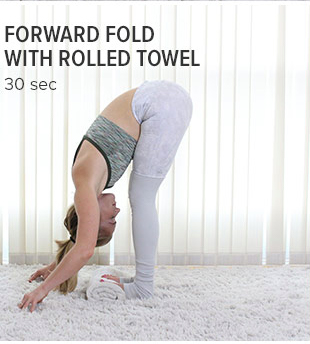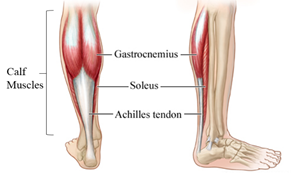What is a Calf Muscle Strain?
Calf muscles are powerful, and part of the posterior chain, including all major muscles at the back of the leg and spine (including hamstrings, gluteus maximi, latissimus dorsi and the erector spinae muscles). Keeping these muscles strong is integral for optimal strength, speed and physical performance. (Competitive Sports Clinic)
Calf muscle strain is very common, counting for 12% of all muscle injuries (Physio Steps). Calf muscle strains impact either of the two primary calf muscles; the soleus or the gastrocnemius. The most common issue is a gastrocnemius tear. The gastrocnemius is the powerful superficial muscle at the back of the lower leg.
Sports Medicine Australia outlines the main causes of pain in the calf muscle: “the gastrocnemius is commonly injured in sports which require quick acceleration from a stationary position and quick halts in movement, i.e. tennis, squash, netball or skiing. In many such cases the injury is caused through sudden eccentric overstretch, i.e. the muscle is contracted yet lengthened forcibly and abruptly…..A calf strain may also be more likely in athletes who have tight calf muscles” (Sports Medicine Australia).
Calf Muscle Strain Symptoms
You’ve most likely had a friend who has ‘pulled a calf muscle’ or had this experience yourself. Symptoms of calf muscle strain depend on how badly you have injured the muscle. They include:
- Sudden pain at the back of the leg.
- Intense calf cramps including leg cramps at night.
- Difficulty contracting the muscle or standing on tiptoe.
- Pain, swelling or bruising in the calf muscle.
- Pain when contracting the calf muscles against resistance (eg pushing against a step)
- If the soleus muscle is damaged, pain might be incurred lower in the leg and when contracting the muscle against resistance with the knee bent.
Gastrocnemius strains are graded in three categories according to their severity:
Grade 1 – the muscle is stretched causing some small micro tears in the muscle fibres. Recovery takes approximately 2 weeks.
Grade 2 – there is partial tearing of muscle fibres. There’s severe pain at the junction between the achilles tendon and belly of the muscle. Full recovery takes approximately 2 – 3 weeks with good rehab.
Grade 3 – this is the most severe calf strain with a complete tearing or rupture of muscle fibres in the lower leg. Full recovery can take up to 6 months if surgery is required.
Prevention of Calf Muscle Strain
Sports Medicine Australia outlines a number of ways to prevent calf muscle strain, and recommends RICER (rest, ice, compression, elevation and referral to a sports medicine professional) as soon as it occurs. Some prevention strategies include:
- Keeping your calf muscles strong so they can absorb the energy of sudden physical stress.
- stretching out calf muscles before physical activity, i.e. calf raises. Gradually including weights or additional resistance over time.
- Gradually increasing the intensity and duration of training.
- Allowing adequate recovery time between workouts or training sessions.
- Wearing the right protective equipment including footwear.
- Drinking water before, during and after play.
Yoga is of course a fantastic way to help prevent injury, keeping the muscles supple and agile. Here are some accessible and functional calf muscle poses to add to your warm-up, and wind-down routines. Remember to combine the movement with the breath to maximise blood flow and keep you focused in the present moment.
Best Treatment for Calf Muscle Strain
Massage and yoga are wonderful ways to treat calf muscle strain. Depending on the severity of the strain, begin gentle movements within 28 – 48 hours (including the more gentle yoga poses), for example:
- Forward bends with a rolled up towel under your toes, and your knees bent as much as you need. Always pulling back from any exercise if you feel and searing pain. Dropping the head and neck, also brings a feeling of relaxation to the mind and body.
- Movement based Down-Dog, or ‘walking your dog’ stretches and opens up the entire posterior kinetic chain. By stretching out from one leg to the other, the backs of your legs from the glutes, to the hammies and calves are nicely worked out.
Check out this video, and just do whatever feels good for you and your body 🙂

If you are experiencing symptoms of calf muscle strain, first visit your GP to assess the underlying causes, then on the advice of your GP visit your physical therapist for targeted relief, and an ongoing treatment plan (including home exercises between appointments). A single appointment will most likely provide immediate relief but there is no magic bullet for chronic aches and pains. Long term improvements will happen only with ongoing therapy and an active treatment plan.
Book an appointment with a therapist today on 03 8598 9804 or online.
